Grand Prix > Grand Prix of Monaco > Review
|
|
27 May,2008 (Tue)
As always, thank you for your support over the weekend. It’s hard to believe that one–third of the season is already over, now that we have reached the sixth race of the 18–race F1 season. The scene for race number six is the legendary Monaco Grand Prix. Without further ado, here is my report from the Monaco Grand Prix, the last race of the first half of the European Round.
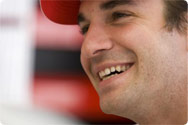
Timo Glock, driving for the first time at Monaco as an F1 driver. Timo showed good form and a flawless weekend practice, but suffered from unidentifiable pace issues during qualifying to miss moving on to Q3.
Prepared for the narrow, twisting Monaco course with high-downforce spec aero parts
At the joint testing session held at Paul Ricard last week, we spent the first two days testing our high–downforce aerodynamic parts that we planned to use for the Monaco GP. Specifically, both front and back wings have been newly designed. We also added another set of top engine cover wings to the rear of the roll hoop wing attached on either side of the induction pod. We installed a small winglet to the vertical runner extending downward from the crash wing at the opening of the side pontoon. Further, we attached gurney flaps around the car. It goes without saying that we were able to produce significant downforce.
While our comparative position during the testing wasn’t the best, we weren’t that worried since each of the teams were running with different fuel levels. We also knew that our driver Jarno (Trulli) was a specialist at Monaco, having won the race before. Jarno’s teammate Timo (Glock) had a podium finish at the GP2 series event at Monaco last year, so I expected our drivers to both have even greater motivation than ever.
With reports of uncertain weather during the weekend, both drivers and team staff worked diligently to make every preparation to be ready for any type of conditions.
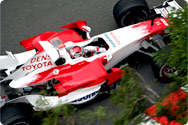 In contrast to Timo, Jarno’s weekend was marred by setup issues. Despite some car damage during practice, Jarno showed his veteran’s skill, qualifying P8 on the starting grid.
In contrast to Timo, Jarno’s weekend was marred by setup issues. Despite some car damage during practice, Jarno showed his veteran’s skill, qualifying P8 on the starting grid.The challenging course even bares its fangs to veteran Jarno; accident causes program changes
Blessed with dry conditions on Thursday, we planned to put in a full day’s work during free practice, but we never imagined that the track would rise up and bite a veteran like Jarno. During Thursday morning’s practice, Jarno’s left rear tire touched the guardrail coming out of the Portier Corner before the tunnel. With a damaged suspension, Jarno’s car couldn’t make it back to the pits, but rather proceeded straight through the chicane to stop at the side of the course. In the end, we only drove 16 laps during morning practice.
During Thursday’s afternoon practice, the bottom of Jarno’s car was damaged coming off the curb out of the Poolside Chicane. Fortunately, the red flag came our while we were repairing the car in the pits, reducing the time our competitors had on the track and preventing our loss of time from being very costly. In the end, we only put in 28 laps–not as many as we had hoped. Our plan was to test both types of dry tires during the afternoon practice using both drivers, but we had to make an emergency change in plans, having Jarno run a program focusing mainly on car setup.
Meanwhile, Timo, in his first F1 appearance at Monaco, was surprisingly steady through the whole practice program. Given Timo’s driving style, which tends to slip the back tires slightly, we were a bit worried. But Timo finished his program without any major mistakes, helping us collect valuable data.
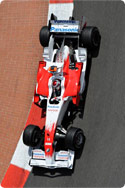 Panasonic Toyota Racing brought new front and back wings as part of the “Monaco specification.” The team also added two types of new wings to the side of the car, making modifications to get the most downforce possible during the race.
Panasonic Toyota Racing brought new front and back wings as part of the “Monaco specification.” The team also added two types of new wings to the side of the car, making modifications to get the most downforce possible during the race.A mysterious loss of speed for Timo; Jarno recovers from difficult circumstances to capture P8 in qualifying
Saturday’s qualifying produced another set of unexpected results. With Timo completing setup work during Saturday morning practice without any issues, we felt like we had a solid package ready for qualifying. Timo looked good through the first qualifying period, but we didn’t see the kind of time gains during the last attack run of Q2 that we were expecting.
According to Timo, the car performed well to through the end of the tunnel in Sector 2, but for some reason lost grip on braking in the chicane. The air pressure in the tires was exactly the same as the prior set, so the loss of speed was completely incomprehensible to us. Timo was turning in quicker times than Jarno through to the tunnel exit, so obviously both drivers would have progressed to the final qualifying period if not for this speed loss.
On the other hand, Jarno, who had been having a difficult time on Thursday, displayed the true strength of a veteran during qualifying. We had a hard time dialing in a setting during Saturday morning. During Q1 and Q2, Jarno reported back that the car was stiff and felt like it lacked any grip. But Jarno went all out in his attack laps during qualifying, ignoring the setup deficiencies. Finally getting some grip during the final qualifying period, Jarno recorded a time moving him to P8, starting on the grid from a position to fight for the points, despite the tough conditions.
We consider the Monaco GP to be two separate races. The first is qualifying, and the second is the fight for position off the starting grid. With the end of the “first” race, we went to the “second” race intent on getting a start to protect our position.
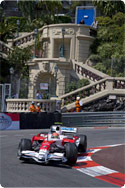
At the mercy of the capricious weather during the race, the drivers faced a difficult challenge. Despite the tough conditions, Timo drove a complete race at his first Monaco GP.
Our strategy completely backfires, keeping us from moving up
Not only was Sunday’s race our worst result of the season, but uniquely frustrating as well. Both of our cars did get off to our best start, yet, which makes our results all the more disappointing.
Let’s start with Jarno’s pit stop. We started on the shallow-grooved wet tires like many of the other teams. Moving up to P7 immediately after the start, we then got as high as P6, all the while fighting the slippery track. Seeing how the race was developing, we stood by with the deep-grooved wet tires, ready to change should anything happen. Sure enough, on lap eight of the race, the safety car came out. Our information indicated heavier rains to come, so we made the decision to bring Jarno in, and betting on a change over to the deep-grooved wet tires.
Contrary to predictions, the rain slacked off, the track dried much faster than we had expected, and conditions became difficult for the type of tires we were running. We changed Jarno back to the more shallow–grooved wet tires at the scheduled pit stop, after which the track immediately shifted to completely dry conditions. This forced us to make a third pit stop. At that point, despite fighting for a place in the points for the first stint, Jarno’s race was essentially over. Jarno finished the race at P13.
Timo was able to move up two positions during the opening lap of the race, maintaining P7 until an unfortunate spin on lap four. Later, the rear wing came into contact with the tire barrier when the car couldn’t quite make it around Mirabeau Corner. We weren’t able to take advantage of the change to dry tires, either, and Timo finished the race at P12.
While we are certainly happy that both cars made it through the tough conditions to finish the race, the results leave much to be desired. We’ll be looking to take the lessons learned to Canada, making up for our disappointment here. We ask for your continued support.
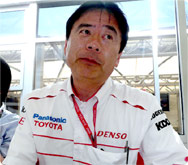
Noritoshi Arai in Monte Carlo. The team’s tire strategy backfired, costing them a chance for points. The Canadian GP tends to be a rough race, but Panasonic Toyota Racing is aiming for both cars to finish in the points there.




